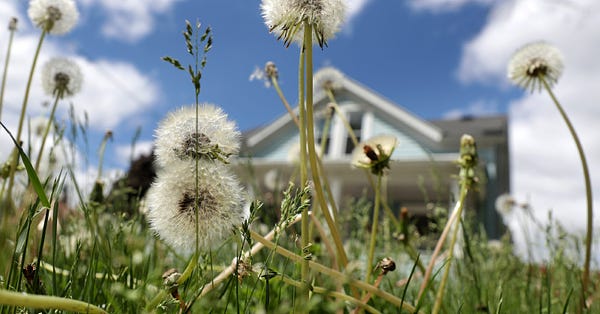At Steady, we are always on the lookout for different kinds of news stories that inspire, provoke thought, and, yes, induce some hope and steadiness.
We came across just such an article recently in The New York Times. It was written by Anne Readel, who is described as “a photographer, writer, biologist and lawyer.” It’s quite the list of credentials and a reminder that many of us wear multiple professional and personal hats.
During an era of momentous events, this story could be considered “small” or “quaint,” but that scale of size is part of what makes it so powerful. I would argue that in a world that often seems out of balance, we can build progress from small individual actions that are transformative in their collective impact.
The article is titled, “In Wisconsin: Stowing Mowers, Pleasing Bees,” and it asks in its subtitle a question that pretty much explains its central idea: “Can the No Mow May movement help transform the traditional American lawn — a manicured carpet of grass — into something more ecologically beneficial?”


The story tells about something special taking place in Appleton, Wisconsin. Dr. Israel Del Toro and Dr. Relena Ribbons, two assistant professors at the local Lawrence University, wanted to see if Americans would rethink that quintessential foundation of many neighborhood landscapes: the lawn. The idea is as simple as it is revolutionary: avoid mowing lawns, and by doing so, allow flowers (often considered weeds) to sprout to support the bees. Aware of a No Mow May movement in England, Del Toro and Ribbons hoped such an effort could also take root in the United States. It has been an unqualified success.
As Readel writes:
I learned about No Mow May in the fall of 2020 when I was looking to make my own yard more friendly to bees. The following spring, I helped organize No Mow May in Shorewood Hills, Wis., where I live. When I realized how quickly the movement was spreading, I started photographing it across Wisconsin.
The article is illustrated with Readel’s wonderful photographs.
This month, the city of Appleton turned the experiment into an annual event:
What I find so inspiring about this article and the larger No Mow May movement is its recognition that we humans are foolhardy to try to control nature — that in our homogenization of our landscapes, our search for tidiness and uniformity, we not only miss out on the beautiful wildness of Earth's diversity, but we also do real damage to its function.
The problem with disappearing bees goes back many years, and it is a topic on which I previously reported for my former newsmagazine program, Dan Rather Reports. Scientists point to many possible causes for bee disappearance, which is matched by a worrisome and precipitous decline of insect populations more generally, but habitat loss is certainly a key component.
Letting a few lawns grow wild isn’t a panacea, but it’s a start, and starts are important. If the movement spreads, as it seems to be doing, a patchwork of parcels in one place can be multiplied across regions and even continents. It can also provide an on-ramp to greater action. The article notes people who started by not mowing their lawns are now looking into other ways they can help support bees.
Seeing the world and one’s surroundings from new perspectives can in turn inspire self-reinforcing changes in thinking. When this phenomenon occurs on a community level, we build bonds with each other. In recent years, many people I’ve met and readers I’ve heard from have asked me how they can fight back against despair. I have often responded that they should start at the local level. Invest in where you live, and reach out to others who live there. Try to find people who are different from yourself, and seek common interests.
In this article, there is no mention of politics. It may seem like the hot-button issues that dominate so much of our discourse are absent. But I see them in different ways. This is about respect for our Earth and its health. This is about evolving from the way things have always been done. This is about sharing knowledge and enthusiasm with others. This is about hope.
In these ways, this isn’t a small story. It is a story about who we are, how we relate to nature, how we try to fix what is broken. It is about seeing that change is possible. And seen from this angle, the stakes couldn’t be higher.




Thank you for spreading this story! Hopefully more towns will pick it up! Another bee friendly initiative is to stop mowing the medians on highways.
Mr. Rather and Mr. Kirschner, are of course extremely articulate in conveying clearly their opinions and ideas - it’s not a surprise because of their stature, I am a fan. Spurred by their inspiring phrases, I did some research about bees. Hence, I came to my senses and realized that, yes indeed, skipping lawn mowing in May is good for the bee population. It is the month when the seasonal weeds are in bloom and the worker bees are mostly active gathering nectars, for their hives, to feed the Queen Bees - the ones responsible for reproduction.
Henceforth, in spring, I will leave the flowering weeds to flourish and bloom in my backyard, where I have unhindered control.
Jaime Tanigue SAN Francisco